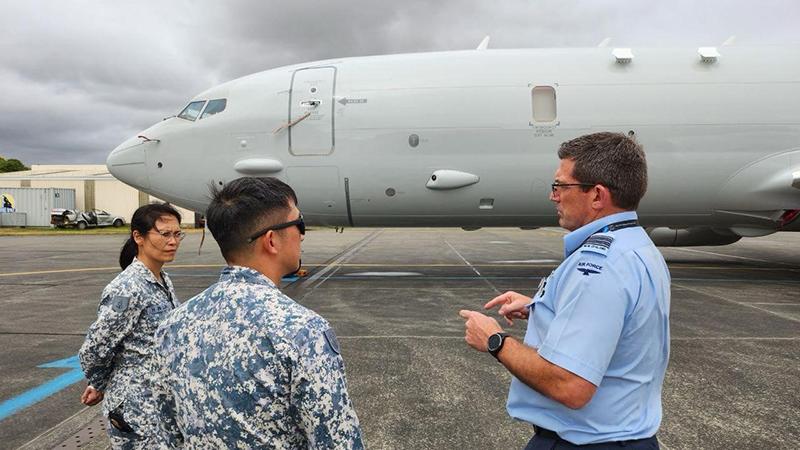This article is published in Aviation Week & Space Technology and is free to read until Apr 11, 2025. If you want to read more articles from this publication, please click the link to subscribe.

Singapore’s defense chief, Vice Adm. Aaron Beng (center), was briefed on the Royal New Zealand Air Force (RNZAF) P-8A on a visit to RNZAF Base Ohakea in March.
Singapore is replacing its aging maritime patrol aircraft in hopes of a performance jump to confront a more challenging geopolitical environment, including the proliferation of regional submarine threats. The country is also looking farther afield to protect its sea lines of communication, underpinning its goal for a more capable system.
The island nation seeks to replace the Fokker 50 Enforcer maritime patrol aircraft (MPA) that its air force has had in service for more than 30 years. Singapore’s Defense Minister, Ng Eng Hen, disclosed the plans in March during a budget debate in the legislature, noting that the service is “intently evaluating appropriate replacements.” Options include the Boeing P-8 Poseidon and Airbus C295, he said.
Israel Aerospace Industries, which has deep ties to Singapore’s defense ministry, has shown interest in offering a business-jet-based MPA. Saab pursued the MPA market with its Swordfish program at one point but shelved the effort after it failed to gain traction.
- Regional submarine threat is intensifying
- The city-state’s navy and air force are looking farther offshore
Singapore is undergoing a far-reaching modernization drive to enhance its navy’s surface, subsurface and uncrewed capabilities, too. The service is acquiring two submarines, expanding its fleet to six, and plans to introduce the Multi-Role Combat Vessel, envisioned as a mother ship for uncrewed systems. Singaporean Navy frigate communications are being enhanced to link them more directly with air force systems.
“Given the growing threats in the undersea domain, such as critical undersea infrastructure, it’s necessary to upgrade existing capabilities to keep pace,” says Collin Koh, senior fellow at Singapore’s Institute of Defense and Strategic Studies.
The naval advancements strengthen Singapore’s effort to ensure its security beyond its immediate littoral area and protect its role as a key node in global maritime trade. That responsibility is also driving requirements for the new MPA with which Singapore intends to support large-scale naval operations at greater distances. The program would require a platform that can deliver advanced processing capabilities for maritime surveillance and sufficient data link bandwidth to enable seamless integration with both crewed and uncrewed assets.
Singapore is expected to retain its focus on the ability to use the aircraft to engage targets if needed. Its Fokker 50 is still the only MPA in Southeast Asia equipped with anti-ship capabilities, and the military is unlikely to forgo this feature. In fact, the Singaporean Navy may seek additional offensive capabilities—particularly anti-submarine warfare systems—to support its expanding submarine fleet in the more contested underwater environment.
Fielding a longer-range submarine-hunting capability would fit in with the Republic of Singapore Air Force’s other steps to expand its reach. Those plans include introducing Airbus A330 Multi-Role Tanker Transport aircraft and setting up an operational detachment in Guam to elevate air-sea training.
The P-8 could be the front-runner in Singapore, in part because it offers close ties with the U.S. Navy and is operated by security partners Australia, New Zealand and the UK. Singapore gained a close look at the P-8’s capabilities in 2019 when the U.S. Navy sank a decommissioned ex-USS Gerald R. Ford frigate during an exercise off the coast of Guam.
Local industry also appears to be expecting a nod in favor of the U.S. platform. ST Engineering, the Singapore Air Force’s principal maintenance, repair and overhaul provider, signed a preliminary agreement with Boeing in 2023 on collaboration in systems integration, training, local parts distribution, support and sustainment work for the platform. Under the agreement, Singapore could serve as a regional P-8 service center in an arrangement similar to one that Boeing struck in Australia as part of that country’s purchase of the P-8 system.





